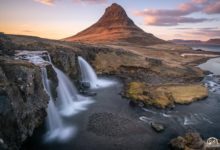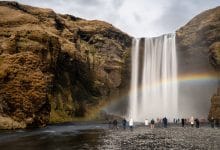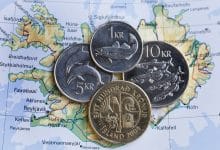Iceland, the land of fire & ice… If somehow this island nation hasn’t made it onto your bucket list yet you’ll want to follow along and add it sooner than later. But when is the best time to visit Iceland you ask?
Every season in Iceland has its own ups and downs. When the weather is the best you’ll have to deal with the massive yearly influx of tourists and when it’s bad, well, it’s really bad. In this blog post we’ll explore when the best time to visit Iceland really is and what you should be doing once you get there!
Hang Tight! The results might surprise you!
The Best Time To Visit Iceland
Iceland has grown to become a hugely popular tourist destination. It’s somewhere that’s become an easy market for airlines from both Europe and North America and the competition is fierce. The result? Cheap airfares… But these inexpensive flights are usually offered in the ‘off’ season. Every time you see one you probably ask yourself “Whens the best time to visit Iceland?”
The next time you see a cheap flight from your local airport to Iceland (KEF) just book it. No matter when it takes off. Simply pack your backpack, you’ll end up having the experience of a lifetime.
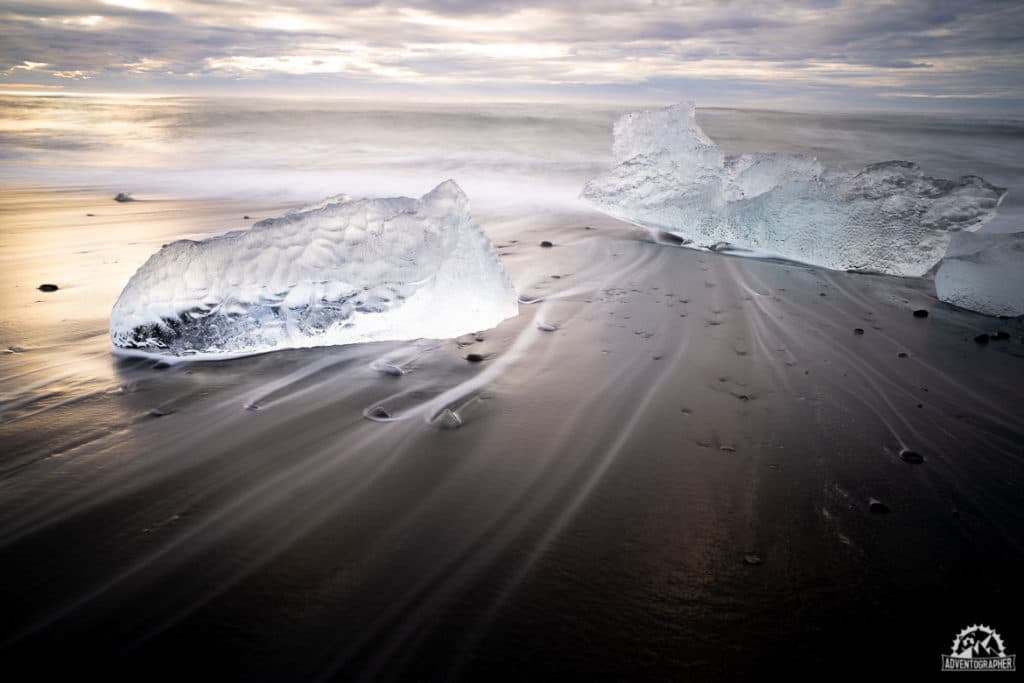
Each and every season is unique and while people may have their own preferences on when to visit. My take is that there is no “best time” to visit Iceland! Summer might have the best weather but it’s also the most crowded. Winter is cold but you’ve got a great shot at seeing the northern lights. Each season has its own pros and cons.
Follow along as we explore what those are as well as some of the best activities you can get in on for that season!
Spring in Iceland
Technically, springtime begins March 20th and ends June 21st. However Iceland, being quirky as it is, has its own way of deciding when spring has sprung. Traditionally, Icelanders consider the beginning of spring to be whenever the first Golden Plover (a seasonal bird) is spotted returning to the island.
Spring is a transitional time in Iceland. The days start getting longer and the weather warmer but the mountain peaks remain snow-covered and silent. The ice begins to melt and vibrant colors start returning to the valleys, additionally, a lot of winter activities will still be available early in the season!
Aside from all that, logistically Iceland becomes much more friendly for travellers. The island is much less crowded and both accommodations and rental cars are easier and cheaper to book.
Track Down the Puffins
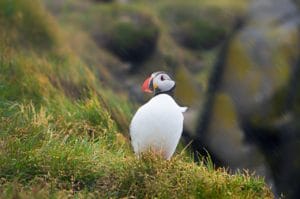
This one’s for the bird watchers out there but is equally as interesting to those of us who don’t know the scientific names. Iceland is arguably the Puffin capital of the world. Because these seabirds spend the winter- rather more than 2/3 of the year- out at sea they are a rare sight to see except when they come ashore to breed.
In the late spring these birds, known as ‘sea-parrots’ or ‘clowns of the sea’ due to their bright & unique colors, flock to the sea-cliffs of Iceland en mass. Their arrival draws photographers, scientists and bird lovers from across the globe.
Some of the best spots to spot the Puffin are the Westman Islands and Dyrhólaey on the south coast.
Go Whale Watching
Whale watching is another of the amazing things to do throughout the summer in Iceland. The coast’s cold north Atlantic waters play host to a diverse variety of marine life. Tours leave from almost every coastal town daily throughout the spring & summer.
Whale watching excursions will get you up close and personal with Orca, Minke and Humpback whales with an almost blemishless success rate. If you get really lucky people have even reported seeing the world’s largest mammal, the blue whale, while whale watching in Iceland!
Find the Waterfalls
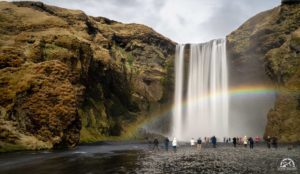
The waterfalls in Iceland are some of the most beautiful in the world! Hunting them down while they’re flowing their fastest in the spring provides a real rush!
The south coast of the country has the largest number of waterfalls in close proximity to each other. But western and northern Iceland lay claim to some of the largest. In fact, Europe’s most powerful waterfall (by volume) lives here!
From waterfalls you can walk behind to waterfalls hidden in slot canyons and even hot water waterfalls Iceland has a little something for everyone!
Summer In Iceland
A lot of travellers will tell you that the best time to visit Iceland is in the middle of summer. Summer in Iceland is, well, busy to say the least. The full weight of the tourist influx strains Iceland’s infrastructure and prices go from high to higher.
Lengthy days (bordering on 22 hours of daylight mid-June) make seeing a sunrise or sunset a little more difficult but allow you to easily pack a ton of exploration into a single day! Those long days also give photographers (like me) lengthy golden hours and make photos come to life!
Drive the Ring Road
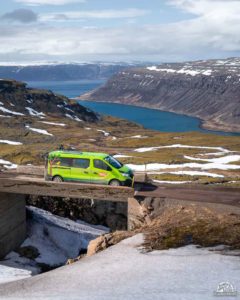
While not limited to the summer months an Iceland ring road tour is best experienced with good weather. Renting a car or camper van and spending a week to 10 days touring around the island is not to be missed.
This 1332km drive without adding in the must see areas of Snaefellsness, the West Fjords or East Fjords is a roller coaster of amazing sights. In some areas you’ll be stopping every 5 minutes to explore something new!
We drove over 4000km on our 10 day tour around the island and still didn’t see it all! Don’t forget to fuel up often, some areas get pretty remote, but thats the point isn’t it?!
Snorkel The Silfra Fissure
Sitting on the mid Atlantic ridge, a rift between the North American and Eurasian Tectonic plates, Iceland is literally being ripped in two. This is easily seen at Thingvellir national park. Here you can walk down the middle of the fault that’s growing at nearly 2cm (1”) per year!
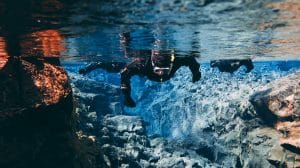
For the adventurous amongst us however, snorkeling or diving the Silfra Fissure is the best way to explore this unique feature. Where else in the world can you swim between the continents?? The water is impeccably clear and the provided dry-suits will keep you warm and comfortable. Though the fissure remains accessible & unfrozen year-round this adventure is a bit more enjoyable in the heat of summer. I wrote all about snorkeling the silfra fissure here.
Hike In The West Fjords
Iceland’s west fjords are some of the least traveled and most rugged parts of the country. The West Fjords are home to cute towns, stunning scenery and some amazing hikes! From day hikes up the local ski areas, to the top of Dynjandi waterfall or visiting extinct volcanoes to multi-day treks the West Fjords have it all!
Hornstrandir nature preserve is the crown jewel of the West Fjords. This remote slice of wilderness, sheer sea cliffs & rolling verdant hills warrants a 3-5 day trip. The preserve is very remote however, there are no roads and hiking access is by boat from the small town of Isafjordur.
It’s a perfect spot get lost in order to find yourself!
Fall In Iceland
Following the summer rush, Fall can be the best time to visit Iceland. Warm days give way to crisp, cool evenings and the days grow shorter. The weather is less predictable but what you give up there you make up in having locations & attractions to yourself. The weather is typically still inviting and most of the tourist infrastructure is still in place and open making it one of the best times to visit Iceland.
In the fall, flight prices (from north America) crash—excuse the pun—from their summer highs. Then the off season rates come into effect and the costs of visiting Iceland become a little more palatable. For the budget traveler winter and the shoulder seasons could be the best time to visit Iceland for this alone!
Visit the Hotsprings
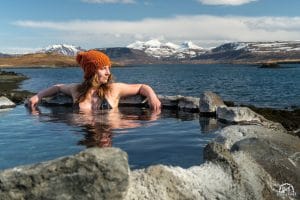
Iceland’s Hot Springs are some of the most prolific in the world. A happy by-product of the island essentially being a giant volcano I guess. Finding and soaking in these amazing hot pots is a whole blog post of its own (I wrote about the Hotsprings In Iceland here) but there’s no better way to relax here.
With the tourist numbers dwindling from the summer swell you’ll find many of the favorite hot springs are sitting unused simply waiting for you to show up! If you chat up the locals they just might reveal the locations of their favorite off the beaten track spots 🙂
Read Also: Iceland’s Blue Lagoon – Tranquil or Tourist Trap?!
Check out a Roundup
In the fall, farmers all over Iceland riding around the mountains & rounding up their sheep and horses after a long summer of grazing. Farmers drive all the animals to a common sorting area called a rétt. Driving around the ring road this time of year you’ll likely spot a few of them. They’re easily identified by the bustle of activity and animals.
The atmosphere around the roundup is jovial and many Icelandic families & neighbors come together to make it happen. Don’t be afraid to stop in & check it out, the locals are always welcoming! You’ll likely get invited to help and then join them in a meal! That’s about as authentic an Icelandic experience as you can get in my mind!
Iceland In Winter
Spectacularly barren and somewhat monotone, winter isn’t the time of year most people consider visiting Iceland. If you’re after a different experience void of the endless summer crowds however this might be the perfect time to visit!
In the winter, the days, while short, are crisp & clear. Although the Icelandic winter is cold the suffering is worth it as the elusive aurora (northern lights) makes a comeback & around town, restaurants and bars are quiet.
During the winter it’s easy to strike up an interesting and insightful conversation with the locals. This might lead you to some off the beaten track attractions. Visiting the main tourist attractions around the island is easy in the winter; you won’t find long lines or crowded ques anywhere.
Winter time could be one of the best times to visit Iceland. And despite the cold there are still tons of great activities available to partake in. If you’re lucky enough to be in Iceland over the New Years holiday, Reykjavík’s fireworks show is touted as one of the best on the planet!
Hunt The Northern Lights In Iceland
Iceland is one of the premiere spots in the world to experience the Auroa Borealis. The northern lights in Iceland can be elusive but the clear, crisp nights of winter are the best chance you’ll have at seeing their beauty.
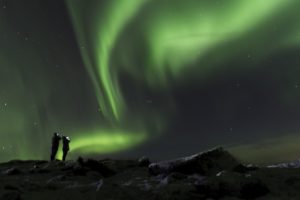
You’ll need a few things to go right before conditions will be right to go aurora hunting. The first being a surge of solar activity. I used the Vedur.is Aurora Forecast to determine my chances of witnessing a display. If you’re lucky enough that the solar activity is high then you’ll want to find clear sky’s away from the light pollution of cities and towns.
While the chances of spotting the aurora are high avoid booking your trip solely for that purpose. In fact, Yellowknife in Canada’s arctic has more clear nights yearly than the majority of Iceland.
Snowboarding & Skiing In Iceland
Not as well known or popular as some other European ski destinations, Iceland still holds its own! Small ski resorts dot the island’s glaciers and some cat & heli ski operations offer unique trips like skiing all the way to the ocean! There are no trees to run into either! Ski season here is typically December-April and most resorts are fully lit to allow you to continue skiing well into the afternoon once the sun has set!
Snowmobiling, Glaciers & Ice Caves
Winter in Iceland is the perfect time to explore the inside of a glacier through an ice cave. Most ice cave tours operate only through the winter since the caves become unstable through the spring and summer.
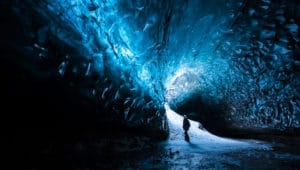
If the gorgeous ice cave photos don’t draw you in maybe getting there will. Tour operators run variations on the ice cave tour arriving via a glacier hike for the fit & adventurous, a snowmobile ride for the thrill seeker or a massive tired superjeep for the more comfort inclined among us.
Exploring the Glaciers and ice caves is a uniquely winter experience in Iceland!
Our Favorite Places To Stay In Iceland
Offering both clean quiet dorms and comfortable private rooms right in the heart of Reykjavik the Hostal Hlemmur Square is perfect for your stay in the capital! If you’re looking to splurge during your stay in the city however, getting a room at either of the conveniently located Sand Hotel or the Ion City Hotel will put you in a perfect position to explore the city.
Outside of Reykjavik accommodation offerings get slimmer. But they’re still out there!
In Vik we enjoyed the Puffin Hostel, but also heard great things about the Icelandair Hotel Vik.
In Myvatn while visiting the hotsprings the Icelandair Myvatn Hotel is an obvious choice.
And in the second city of Iceland, Akureyri the Kea Hotel was a standout.
If none of those options tickle your fancy you can always rent a Campervan in Iceland like we did and take your bed with you every day!
So? What’s The Best Time to Visit Iceland
The simple fact is that there is no “best time to visit Iceland”. There’s no “bad” time to visit the country at all! Simply different experiences to be had! Who you are and what you crave in your travel will dictate when you should visit Iceland and nothing else!
Related: How to Pack For Iceland!
So? Which would be your perfect time to visit Iceland? Why? Drop a comment below, I love hearing your thoughts! If you enjoyed this post I’d love if you’d share it on social media, everything helps!


